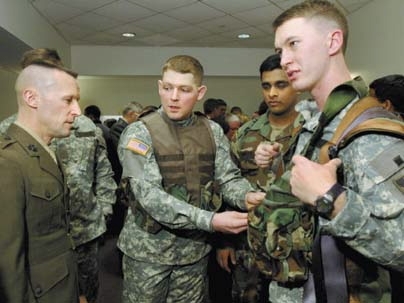Power, cooling and casualty evacuation were recurrent themes at the final judging of the second annual MIT Soldier Design Competition--a reflection of the harsh realities of soldiers' lives in combat.
About 200 people gathered last Tuesday to watch 15 teams of students from MIT and the U.S. Military Academy at West Point demonstrate prototypes of practical, non-weapons devices of use to soldiers, as well as to police, firefighters and other emergency first responders. The competition is sponsored by MIT's Institute for Soldier Nanotechnologies.
The five undergraduate cadets of team "Supercharged" from West Point won the Raytheon first-place award of $5,000 for their battery scavenger system for recovering the power remaining in depleted batteries. Pocket-sized, rugged and inexpensive, the device could reduce soldiers' battery needs by 15 percent to 20 percent, providing significant savings in weight carried in the field, environmental impact and cost.
The Boeing second-place award of $3,000 went to the "Ancile" team, also from West Point, for its computerized tracking system that provides soldiers with advance warning of incoming strikes through small radio pagers. Team "ATLAS" from MIT took the SAIC third-place award of $3,000 for its powered rope ascender.
One fourth-place award of $2,000 went to each school: Team "Joe Proof" from West Point took the Charles River award for its hands-free casualty carriage system, and team "Grapefruit" from MIT took the Hudson River award for its battery scavenger and recharge system. A director's award of $1,000 for special achievement went to the "Cool Warrior" team for its cooling system for Interceptor body armor.
"This competition is about putting new technology into soldiers hands soon," said Professor Ned Thomas, director of the MIT Institute for Soldier Nanotechnologies. "These are real problems we're addressing, and the Army is very interested in the innovations that are coming out of these student teams."
The Army was so impressed with one of last year's winning inventions--a system to digitize soldiers' hand-arm communications signals--they have funded the team with a small-business research grant to continue development.
The judges for the finals included uniformed and civilian representatives of the Army and Marine Corps, as well as individuals from MIT and industry. Gen. Benjamin Griffin, senior Army guest at the event, was very impressed with the students' and cadets' efforts on behalf of soldier protection, noting that fresh ideas can often bring solutions to old problems.
"These ideas have direct application to the challenges of today's Army," said Griffin, who is commanding general of Army Materiel Command. " From where I sit, there is nothing more important than what you're doing here tonight."
A version of this article appeared in MIT Tech Talk on March 9, 2005 (download PDF).






